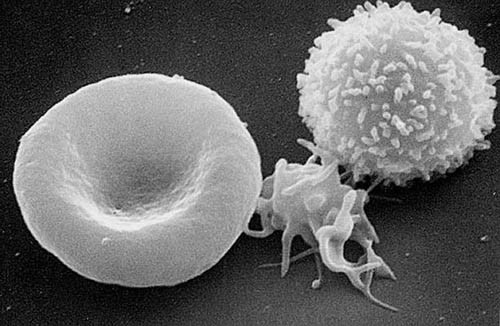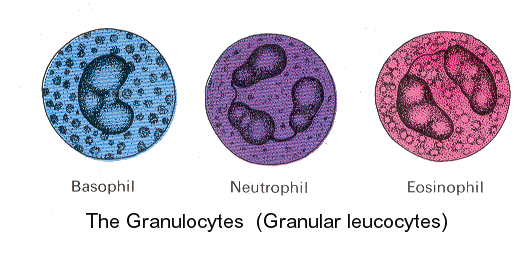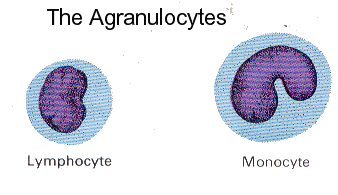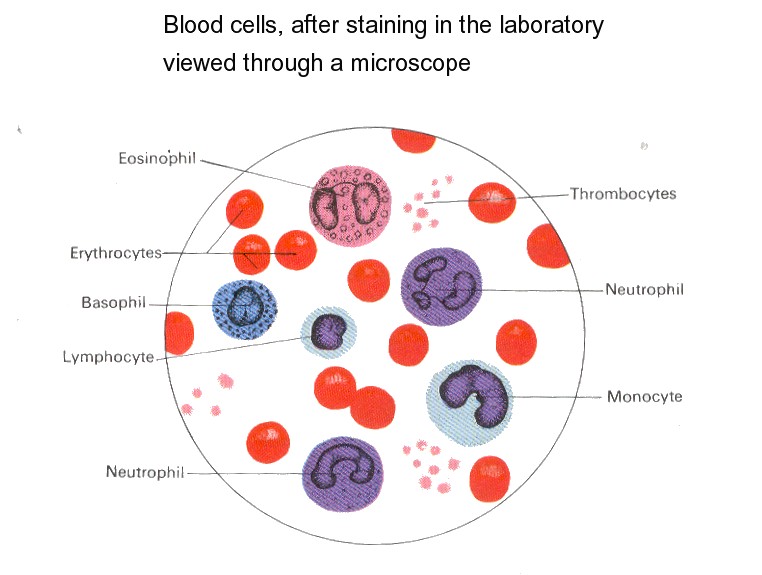The Blood Tissue
Definition
A constantly circulating fluid providing the body with nutrition, oxygen, and waste removal.
Has numerous cells and proteins suspended in it
The average person has about 5 liters
A liquid called plasma makes up about half of the content of blood.
Blood is circulated through blood vessels (arteries and veins)
Contents
Red blood cells, which carry oxygen to the tissues
White blood cells, which fight infections
Platelets, smaller cells that help blood to clot
Plasma, which contains proteins that help blood to clot, transport substances through the blood,
Plasma also contains glucose and other dissolved nutrients.
White Blood Cells
Synonym : Leukocytes
Largest of the blood cells
Have nuclei
Are of two types -
granulocytes (polymorphonuclear leukocytes) - neutrophils, eosinophils and basophils;
agranulocytes - monocytes and lymphocytes
Granulocytes have multilobed nuclei in the cytoplasm
Neutrophils
attracted to area of infection by chemtaxins
ingest and kill or get killed by phagocytosis
killed cells form pus
the granules, lysosomes contain the enzyme which degrade the ingested materials
count increases in microbial infection and tissue damage by inflammation, infarction, burns, crush injuries
from myeloblasts become myelocytes
differentiate into three types
Red Blood Cells
Synonym : - erythrocyte,
Millions in circulation
Gives red colour to the blood
carries oxygen from the lungs to the tissues.
Round, and biconcave
The cell is flexible
It is covered with a membrane composed of lipids and proteins
No nucleus, and contains hemoglobin—a red, iron-rich protein that binds oxygen.
Carries carbon dioxide to the lungs, where it is excreted
The red cell develops in bone marrow in several stages: from a hemocytoblast,
It becomes an erythroblast (normoblast)
gradually filled with hemoglobin, and nucleus and mitochondria disappear.
Transforms into reticulocyte ultimately becomes a fully mature red cell.
Life : 100–120 days; there are some 5.2 million / mm3
Platelets
Synonym : thrombocytes
They are fragments of cytoplasm from the megakaryocytes of the bone marrow.
No cell nucleus
biconves discoid structures
2-3μm
Stained platelet : dark purple spots
helps hemostasis at the site of interrupted endothelium
They plug the hole in the vessels
They aggregate and form a plug a "white clot" then a "red clot"
Four zone in a platelet - peripheral zone, sol-gel zone, organelle zone, membranous zone
Plasma
The yellow colored liquid component of blood
It is the extracellular matrix for the blood cells
is the intravascular fluid part of extracellular fluid
Mostly water
Contains albumins, globulins, fibrinogen, flucose, clotting factors, electrolytes, hormones
Serum is blood plasma without clotting factors
Functions
Supply of oxygen to tissues (bound to hemoglobin, which is carried in red cells)
Supply of nutrients such as glucose, amino acids, and fatty acids (dissolved in the blood or bound to plasma proteins
Removal of waste such as carbon dioxide, urea, and lactic acid
Immunological functions, including circulation of white blood cells, and detection of foreign material by antibodies
Coagulation, the response to a broken blood vessel, the conversion of blood from a liquid to a semi-solid gel to stop bleeding.
Messenger functions, including the transport of hormones and the signaling of tissue damage
Regulation of body pH
Regulation of core body temperature
Hydraulic functions
Applied Anatomy
Blood cancer - Leukemia
Spherocytosis, Sickle cell anaemia
Polycythemia vera
Thrombocytopenia - dengu fever







